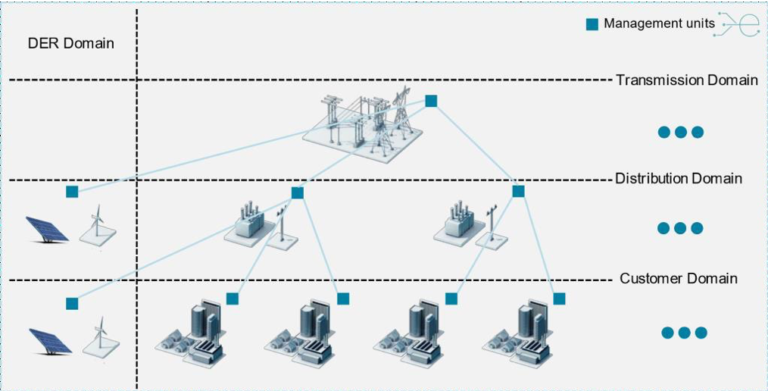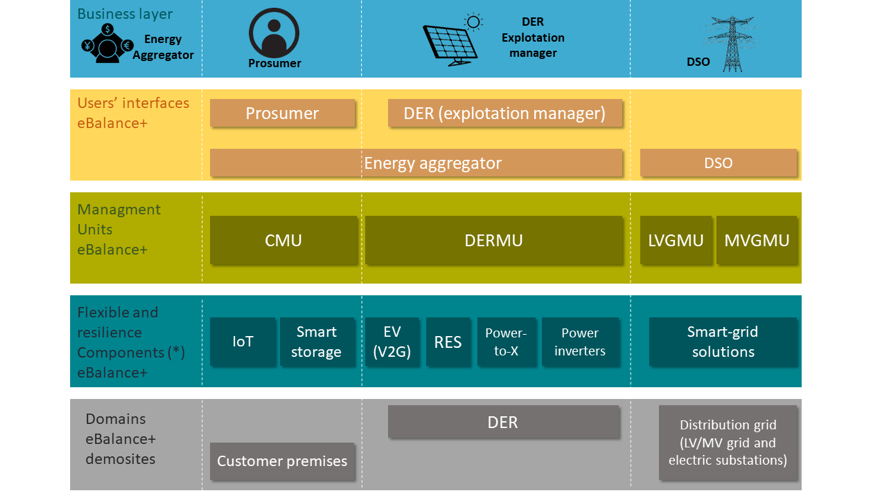Energy flexibility and challenges of the energy markets.
Juan, what are the main challenges for the smart grid market today? If applicable, how does ebalance-plus contribute to the solution of these challenges?
Until recently the customer has not been considered in the electricity grid from the management point of view. Now it is absolutely necessary that the customer domain (consumption, generation and storage) is integrated into the management system. To enable that, new players appear on the market, but their integration is not that straightforward due to a number of reasons.
Just to give an example: the case of energy aggregators. They are the first players that go to the customer level, they can adjust their energy profile, go to a new energy flexibility local market and negotiate the energy on behalf of the customers.

However, there are other players, like the energy retailers who go to the whole electricity market, pay for the energy and sell it to the customers. So, these two players are doing similar things, but in different steps and in different time frames.
There is a lot of potential for conflict, because if the aggregator adjusts the energy profiles of customers differently compared to what the retailer had foreseen, then the retailer can suffer penalties. So, this kind of things have to be coordinated. For this reason, in Spain for example there are high level discussions about the market rules, since this kind of situations can be very disruptive for the classic energy market. And these discussions are vital, also for a project like ours, because ebalance-plus is proposing a framework that is not entirely supported by current regulations, but it can be adapted to any market, providing solutions to all the potential new players.
There are many different technologies that ebalance-plus is dealing with. Could you walk us through them and show how they're interconnected?
We distinguish between a) the physical devices or the technology that we are going to deploy and b) the intelligence or algorithms that will control these technologies.
One of the new technologies that we propose to deploy at our demo sites is based on new power converters – AC/DC Silicon carbide-based converters. The grids are working on AC power, but the DC power has certain benefits for the management and control of the system. These power converters use silicon carbide, a very efficient material, which allows to modify some of the technical parameters of the electricity and make it more efficient.
Another technology is vehicle to grid (V2G). With this technology, we can use electric vehicles as batteries and hence use their flexibility to balance the grid.
The third technology is smart batteries, designed for buildings with large energy consumption and high rated power. We are going to explore the capacity of these batteries at building level. They of course also provide the possibility to optimise costs and diminish CO2 emissions for the building owners.
And apart from these technologies, we are working on a platform which is composed of small PCs, small management units that will be placed on different levels – in the grid domain, customer domain, transmission domain, etc., enabling smooth energy coordination.
Additionally, we have the algorithms that we are going to develop and test in the different demo sites with the objective to manage the energy flexibility in the best way from the economic and environmental points of view, at the same time increasing the resilience of the grid.
What differentiates the ebalance-plus platform from other solutions?
Many projects right now are dealing with digitalisation of the grid, offering the market more information about the grid. Our focus is different – we are not operating with the market only. We are distributing the control of the grid to all levels, so that these levels can coordinate with each other from a technical point of view, of course, also considering economic variables. But the core of the solution is based on the fair cooperation of all the players, from the customer to the energy operators to balance the grid.

And who profits the most from such an approach?
I think it’s a win-win approach and it will have a positive impact in the whole value chain. The customer will have access to new services and more reliable electricity supply. For the Distribution System Operators, this kind of system might seem more complex at first, but at the end they won’t have to invest more in the infrastructure. The classical approach would mean that if they want to deploy electric vehicles, self-generation units at home or a building level, they probably have to extend the grid capacity with new lines, with new transformers, and new devices that are costly. With this platform, we can manage the lower level of the grid and avoid this kind of additional investments.
ebalance-plus aims to increase the flexibility and resilience of the grids. Why is this important?
First of all, it is important to note that there is no unity when it comes to the concept of energy flexibility as there is no strict definition of it. Different players of the energy market can understand different things by referring to the flexibility. So, it’s a difficult concept to generalise. We understand energy flexibility as the capacity to change an energy profile, meaning that we can decide to use more or less energy in certain moments, depending on different conditions.
From the project point of view, the idea is to connect two parts of the energy system that have been disconnected – the management of energy from the DSO point of view and the management of the energy at the customer level.
In a way, the problems that we are solving are those of the future.
In the current energy system, the grid operator (TSO) looks at the energy forecast and then balances the system without considering the information from the customer.
While this might not be such a problem right now, in the future, we will see a higher level of electrification of our lives, meaning that our cars, appliances, etc. will depend on electricity. This will make the energy system more complex. Also, renewable sources of energy are variable and are difficult to predict and balance without the collaboration with consumers.
So, it’s clear that we’ll need a system that will control the new technologies and coordinate them to ensure that the energy supply does not suffer interruptions. This new system would also allow integration of new technologies without increasing the investment in new infrastructures.
On the other hand, talking about resilience, if there is a system that coordinates all the grid levels (from DSO to consumers), the system will recover faster from unexpected accidents, simply by reducing the energy usage in the moment, ensuring the minimum level of energy supply for all the customers, using the available local energy generation to temporary isolate certain grid parts. Considering the increasing level of digitalisation of all aspects of our life, fast recovery of the electricity supply, or the resilience of the grid, will be vital.
You said that ebalance-plus is solving problems of the future. Talking about the future: what are the technology trends that are transforming the energy markets right now?
From the technical point of view, I would say it is a wide capacity storage system. Fossil fuels, ironically, offer a great flexibility and allow to react quickly to the imbalance in the system. Renewable sources of energy are very variable and slow, so it takes a lot time to manage grid stability. So, the challenge is to develop technology that allows energy storage – physically or virtually.
From the management point of view, the transformation of regulations to allow energy communities or energy aggregators operate on the markets.
It's clear that energy systems are becoming very complex socio-technical systems, which combine a variety of automated processes with human behavior and social context. What role do consumers play in these systems or what role will consumers play in the future?

This is a tricky one. On the one hand, the EU is promoting a citizen-centered approach. However, flexibility technologies that appear on the energy market oftentimes do not consider the consumer and rather propose simple automation of services.
On the other hand, you have energy illiteracy of the end consumer. This is something we realised in our previous project, ebalance: Oftentimes, people don’t understand energy concepts or are not interested in the energy market at all. This point is a big barrier that can be tackled only through the collaboration with the academic and education community and it has to be tackled because the energy and its use is something that will be highly present in our lives soon.
So, in a way, experts are developing automatic solutions because they know that in the end the citizens, the consumers will not be in the center, because they don’t care, but we need iterations in this loop to break this circle.
So, with the ebalance-plus, we are working on engagement solutions that on the one hand would provide some information about the energy, so that users can understand what they are dealing with. On the other hand, the decisions that they would make through their mobile apps would have some real and visible effect on the management of the energy flexibility.
The market of energy is going through some rapid changes. Is it the case that most of the solutions that we're developing today might be obsolete in a few years? If so, what can be done to solve this kind of problems?
I think that the solution here is the regulation, because if there are no rules that deal with these issues, most probably we’ll indeed be suffering the effects of fast obsolescence. In Spain, for example, most of the homes are connected to a smart meter. As we wanted to deploy ebalance-plus solutions, we realised that it was not possible to use the full potential of the flexibility mechanisms connecting to these meters. So, it’s important that devices can be upgraded, in order to implement new solutions in the future. For this reason, there are several initiatives from the European Commission to support the legacy of the equipment.
But if we talk about ebalance-plus solutions, our platform is agnostic, scalable and totally replicable because it is following the structure of the electricity grid and therefore is extremely adaptive. The same balance strategy can be extended from higher level to lower level. So, we can replace different units, the database that we use can be extended and the concept indeed can be adapted for future technology. I cannot assure that our devices will be there in 10 years because systems are evolving month by month, but the concept will still be valid. And in this sense, we do offer a framework that will not become obsolete, at least not that fast.

By Daria Kulemetieva from ESCI.